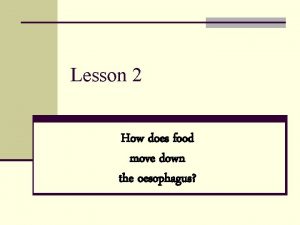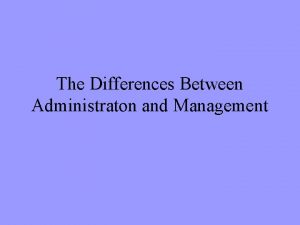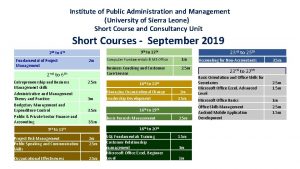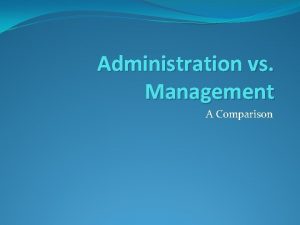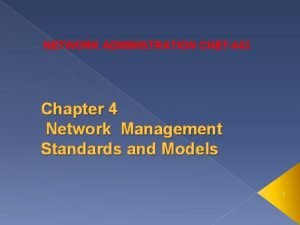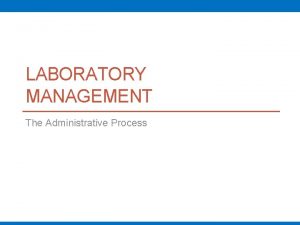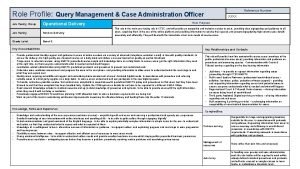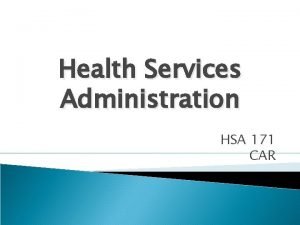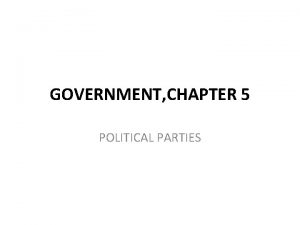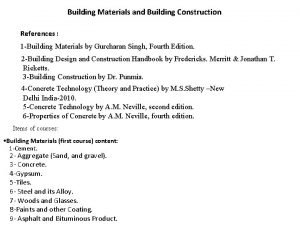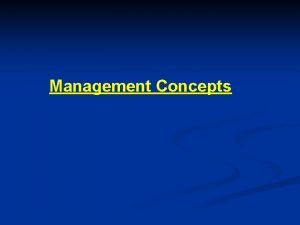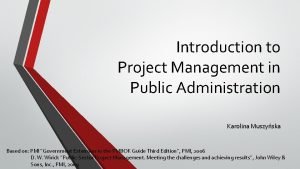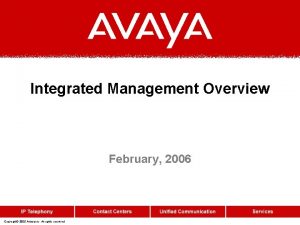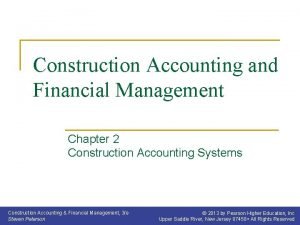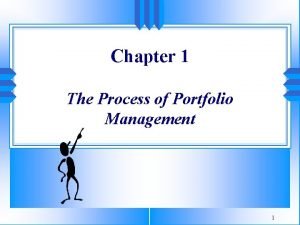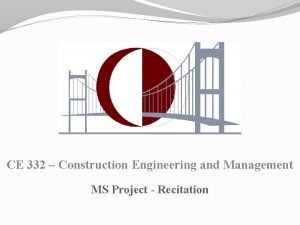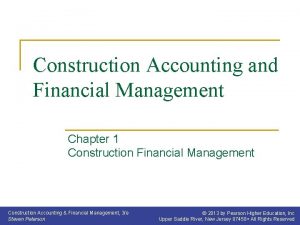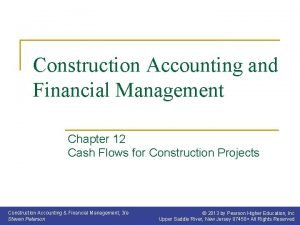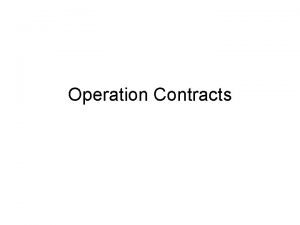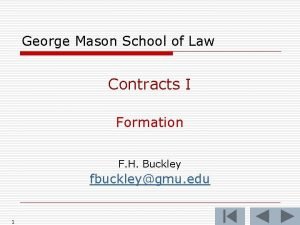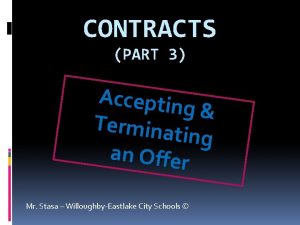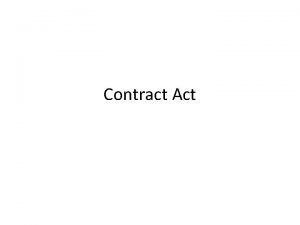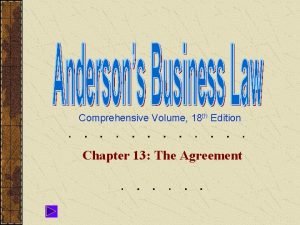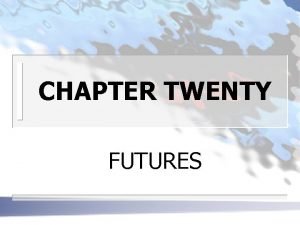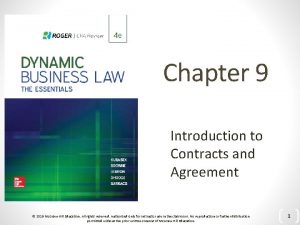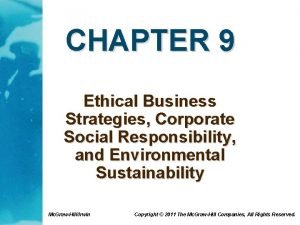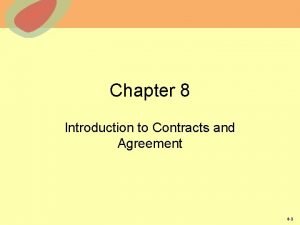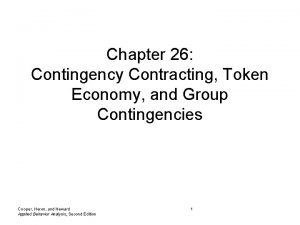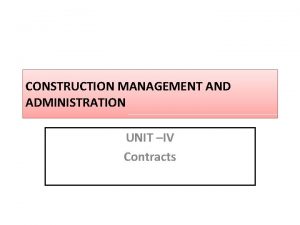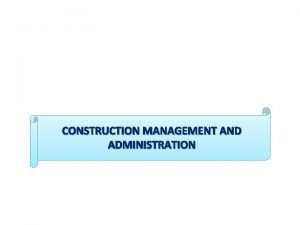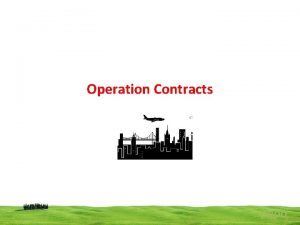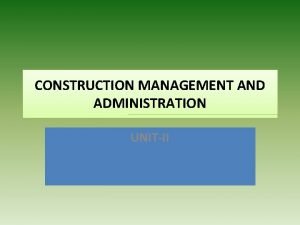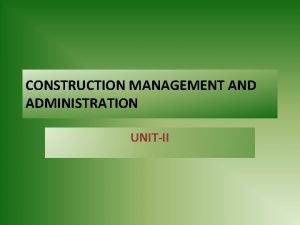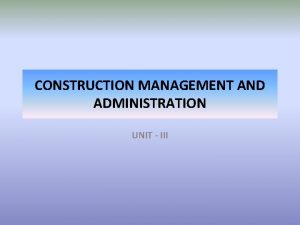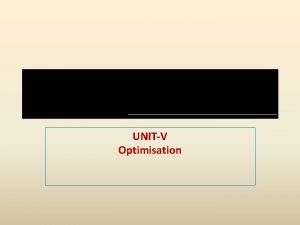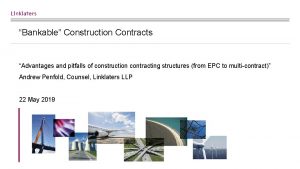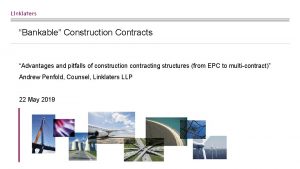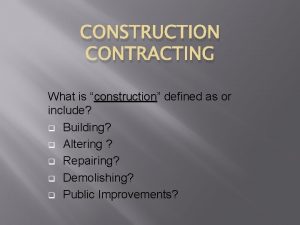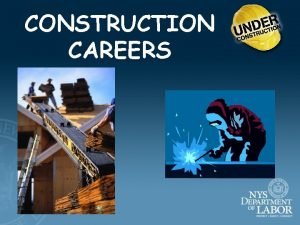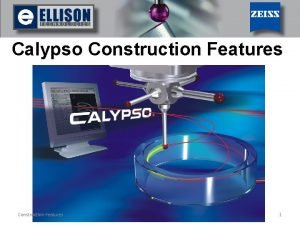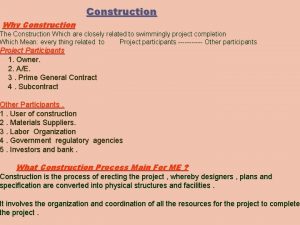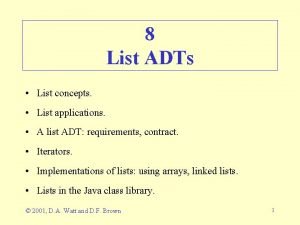CONSTRUCTION MANAGEMENT AND ADMINISTRATION UNIT IV Contracts List
















































- Slides: 48

CONSTRUCTION MANAGEMENT AND ADMINISTRATION UNIT –IV Contracts

List of topics 1. Introduction of contracts 2. Types of contracts 3. Tender drafting and Tender analysis Conditions of contract • 4. Stages of awarding contract • 5. 6. 7. 8. Procedure for execution of PWD works Safety in construction Workmen compensation act Contract labor act Demolition of buildings

Safety in construction Importance of safety in construction • Construction is highly accident prone industry • In India , construction industry is labour intensive , with unskilled and untrained worker. Fatal accidents and minor accidents are very frequent • Safety management is to minimize human pain and suffering , to the worker's family or to the worker , that results due to accident or work induced illness • Safety programme ensures the worker to be mentally and physically prepared to execute a job quickly , fearlessly and efficiently • The cost and time is also dependent on the safety management • A company with a better culture of safety attracts the right kinds of employees and builds a good , consistent safety record


The major causes of accidents in construction industry are due to – 1. Fall from high elevation 2. Electrocution 3. Being struck by equipment 4. Being caught by equipment 5. Trench excavation , cave-in 6. Drowning ( bridge and offshore construction ) 7. Overexertion It has been found that more than 40 -50% of accidents due to fall from height or fall of an object



Safety measures 1. 2. 3. 4. 5. 6. 7. 8. Excavation Drilling and blasting Hot bituminous works Scaffolding, ladders, form work and other equipment Fabrication and erection Storage Demolition Fire safety

Safety measures for Excavation • Experienced and competent foreman/ supervisor should look after the job • Before doing the excavation work, complete knowledge of underground structures is essential and proper precautions should be taken to prevent accident • All the persons involved in the job must wear safety helmet (PPE) • Trenches exceeding 2 m in depth should be securely shored and timbered • Sheathing should be placed against the side of the trench • Around the excavated areas barricades should be erected and at nights adequate lighting should be provided





Safety measures for Drilling and Blasting • To transport small quantities of explosives specially designed insulated water proof containers free from nails shall be used • Vehicles to be used for transporting explosives should be in good condition with tight wooden floors • Smoking is strictly prohibited near areas where explosives are stored • Explosives should be stored only in magazine which is clean, dry well ventilated reasonably cool, bullet and fire resistant • Explosives and fuse lighters should not be stored in a damp places or near oil, gasoline or steam pipes or other source of heat • Any package containing explosives should not be dragged, dropped or handled roughly and these packages should be opened only at a safe distance from the package of bulk storage • No person should attempt to uncoil the wires and open the bare leading wires of the electric blasting caps (detonators) during dust storms

Safety measures for Hot bituminous works • On all major works, an experienced foreman or supervisor should be placed in-charge of the work • Workers engaged in bitumen handling job should use boots, gloves, goggles and helmets • Sufficient stocks of clean dry sand should be made available near bitumen heating site • Bitumen mixing plants should be provided with safe means of access. Working platforms should be provided with hand rails, and pulleys belts and drive mechanisms should all be suitably guarded • Compressors, electrical installations and other equipment such as elevators and conveyors should be adequately protected from weather, mechanical damage and dust particles • When bitumen plants are working on a public road, an adequate traffic control system must be established

Safety measures for Scaffolding, ladders, form work and other equipment • Every scaffold should be securely supported or suspended and properly strutted or braced to ensure stability • All scaffolds and working platforms should be securely fastened to the building or structure • During dismantling of scaffolds, necessary precautions should be taken to prevent fall of loose materials, bracings and other parts of scaffolds • The supporting ballies formwork should be checked for each individual member. The ballies should be properly braced. Many accident occur due to negligence on this account • All operators and supervisors of machines should be thoroughly trained in operating the machines and equipment









Safety measures for Fabrication and erection • All equipment such as gas cutting and welding sets, drills, power hacksaws, grinders etc. should be checked periodically to ensure their safe working • Moving parts of all equipment should be provided with safety gaurds • Workers engaged in gas cutting & welding works should wear suitable PPE such as gloves, apron, welding screen etc. • Power cables for all equipment should be properly insulated and protected from damage and cuts • Danger signs should be prominently displayed on all poles of overhead electric lines at site • Cut pieces and scrap should be stored at a appropriate place to avoid accidents • All lifting tools and tackles such as wire ropes, U-clamps, shackles, chain pulley blocks hooks etc. should be checked thoroughly before use


Safety measures In Storage • Timber including sleepers, runners, scantlings, bullies, plywood etc. should be stored separately in neat stacks. Adequate space should be left in between the stacks to avoid fire hazard • Petroleum products should be separately stored and open fire/smoking should be strictly prohibited • Adequate fire fighting arrangements should be provided • Explosives must be stored in proper magazines



Fire Safety in Buildings • Early warning systems – Smoke detectors – Heat sensitive detectors • All buildings should satisfy fire safety requirements as per IS: 1256 -1967 – All multistoreyed buildings must have separate staircases at every 30 m distance in addition to lifts • Spacing of buildings should ensure adequate protection against exposure of hazards as per IS: 1643 -1960 • Chimney flues and smoke pipes should be provided in accordance with IS: 1645 -1960 • Fire safety for electrical installations in buildings should be as per 16461982 • The design of different structural elements should take into account the fire resistance ratings as per IS: 1641 -1960 • During construction, fire hazards due to electric short circuit can be avoided by proper wiring. Naked and loose wiring should be prohibited. Open fires should be prohibited on construction sites whre inflammable materials are stored


Safety guidelines for Personnel Conduct • Employees should always wear hard hats , safety shoes , eye protection , ear protection , in noisy areas (PPE) • Equipment operator should have the license and training with the equipment operation and safety norms • Stay out of dangerous places • One should not work alone on the site , when other employees are not on the site • New employees should make themselves conversant with safety norms from senior persons of the department

Safety plan Some of the major components of a company safety plan should be • First aid equipment should be available and known to the employees • Every employee should have personal safety equipment. • Formal training program for each employee should be mandatory • Procedures for emergency evacuation of injured employees should be clearly explained and employees should be trained for such situations • Safety record and accident report of the company should be honestly examined • Site visit requirement for supervisory personnel plays a very important role in safety management • Training for all supervisors and the managers should be mandatory




Workmen compensation act -1923 (amended 2009) • Provisions: – Payment of compensation to workmen for injury by accident sustained during the course of employment – It covers workers employed in hazardous jobs – It does not include clerical and administrative staff • No compensation if injuries are due to – Negligence of a worker by willful disobedience of safety and security regulations – Non-observance of safety measures and not using safety guards – Influence of liquor or drugs – Diseases which are not caused as result of working on the job

Workmen compensation act -1923 (amended 2009) • Amount of compensation depends on – Age of workmen – Type of injury and disablement – Percent loss of earning capacity • Medical examination – With in 3 days of injury – No compensation if workmen refuses medical examination – If workmen dies without medical examination, dependents can claim compensation • Appointment of commissioners – For resolving disputes arising out of claims – Payments are made through commissioner

Contract labor (Regulation & abolition) act, 1970 Object: – Regulating the employment of contract labor in certain establishments – Abolition of contract labor under certain circumstances Applicable to: – Establishments with 20+ workmen Not applicable to: – Establishments with casual or intermittent nature of work Provisions: – Constitution of central advisory board • Chairman, chief labor commissioner & members (total 11 to 17) – Registration of establishments – Licensing of contractors – Welfare and health of contract labor • Rest rooms, water+sanitation, first aid box, washing fecilities – Responsibility for payment of wages

Demolition of buildings Why building Demolition? – Expiry of useful life – Uneconomical maintenance – Buildings built illegally Demolition is a process in which an existing building or any such structure is pulled down using some machines, tools and equipments 1. Partial Demolition 2. Complete demolition Partial deterioration of structure Additions, alterations and improvements Natural calamities such as storm, fire, floods, earth quake, land slide etc. The maintenance of repair becomes uneconomical To provide space for new projects Completely unserviceable due to natural calamities

Demolition of buildings Demolition methods can vary depending on The area where it will be held on The building material The purpose of the demolition and The way that debris is going to be disposed Demolition Methods Demolition by hand tools High Reach Arm and or Pusher arm Crane & Ball Implosion or Explosion Selective Demolition

Demolitions-1

Demolitions-2

Demolitions-3

Demolitions-4

Safety measures for Demolition • On every demolition work, danger signs should be provided and barricaded around the area • During night time, red lights should be placed • Every workmen engaged in demolition work should wear PPE • The process of demolition may weaken the side walls of adjoining structure and to prevent possible damage, these walls should be supported • The power on all electrical service lines, gas lines must be shut off before the demolition work is started • No demolition work should be carried out at night

? ? ? . . and discussion

Assignment-4 1. List types of contracts and discuss in detail about “cost plus fixed fee contract” 2. Describe important conditions of contract 3. Explain the importance of safety in construction industry 4. Write a short note on 1. “workmen compensation act” 2. Safety measures for Building demolition
 Ind as 11 construction contracts
Ind as 11 construction contracts Food move
Food move Conclusion of management
Conclusion of management Difference between administration and management
Difference between administration and management According to kimball richman and copen administration is
According to kimball richman and copen administration is Institute of public administration and management
Institute of public administration and management Administration vs. management
Administration vs. management Osi network management model
Osi network management model Laboratory management and administration
Laboratory management and administration Query management and case administration officer
Query management and case administration officer Difference between administration and management
Difference between administration and management Economic protest parties definition
Economic protest parties definition Forwards hedging
Forwards hedging Research and development contracts
Research and development contracts Unit 6 review questions
Unit 6 review questions List of materials required for building construction
List of materials required for building construction Administration definition
Administration definition Revenue management information system
Revenue management information system Project management in public administration
Project management in public administration Avaya integrated management site administration
Avaya integrated management site administration Revenue management information system
Revenue management information system Construction accounting and financial management
Construction accounting and financial management Portfolio construction management and protection
Portfolio construction management and protection Construction engineering and management
Construction engineering and management Introduction to construction financial management
Introduction to construction financial management Construction accounting and financial management
Construction accounting and financial management Do water contracts gets smaller when it freezes
Do water contracts gets smaller when it freezes Computer contracts in professional practices pdf
Computer contracts in professional practices pdf Litter picking contracts
Litter picking contracts Operation contracts
Operation contracts International contract law
International contract law 1872 in indian history
1872 in indian history Mailbox rule contracts
Mailbox rule contracts Mailbox rule contracts
Mailbox rule contracts Parts of a contract
Parts of a contract Next-generation smart contracts
Next-generation smart contracts Mailbox rule contracts
Mailbox rule contracts Contract finance
Contract finance Agreement and contract difference
Agreement and contract difference Mailbox rule contracts
Mailbox rule contracts Futures contracts
Futures contracts Classification of contracts
Classification of contracts Classification of contract
Classification of contract According to integrated social contracts theory
According to integrated social contracts theory Mailbox rule contracts
Mailbox rule contracts Contingency contracting aba
Contingency contracting aba Integrative social contracts theory maintains that
Integrative social contracts theory maintains that Ability one qualifications
Ability one qualifications Muscle contracts
Muscle contracts

